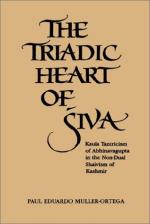|
This section contains 3,916 words (approx. 14 pages at 300 words per page) |

|
Śaivism and Vaiṣṇavism form the two principal religious currents of classical and modern Hinduism. Śaivism centers on the worship of the god Śiva and Vaiṣṇavism on that of Viṣṇu. In classical Hindu mythology Śiva is the god of destruction, generally portrayed as a yogin who lives on Mount Kailāsa in the Himalayas. His body is smeared with ashes, his hair piled up in matted locks. He wears an animal skin and carries a trident. A cobra often serves as his garland and the crescent moon as his hair ornament. He has a third eye, kept closed, in the middle of his forehead. He may be surrounded by his beautiful wife, Pārvatī, and their two sons, the six-faced Skanda and the elephant-headed Gaṇeśa.
The migration of bands of people called Aryans into the northwest of the Indian subcontinent initiates the...
|
This section contains 3,916 words (approx. 14 pages at 300 words per page) |

|




